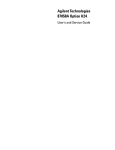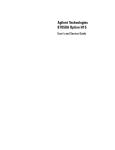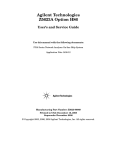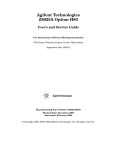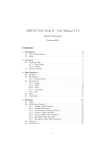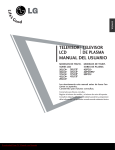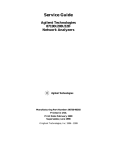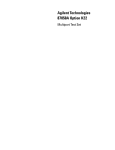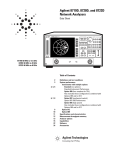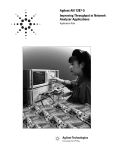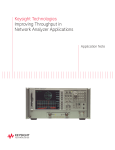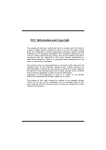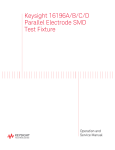Download Agilent Technologies 22D User`s guide
Transcript
Agilent Technologies 87050A Option K24 Multiport Test Set User’s and Service Guide Use this manual with these documents: 8719D/20D/22D Network Analyzer User’s Guide, Part Number 08720-90288 8753D Network Analyzer User’s Guide, Part Number 08753-90257 8753E Network Analyzer User’s Guide, Part Number 08753-90367 8719D/20D/22D Network Analyzer Service Guide, Part Number 08720-90292 8753D Network Analyzer Service Guide, Part Number 08753-90261 8753E Network Analyzer Service Guide, Part Number 08753-90374 Agilent Technologies Part Number: 87050-90022 Printed in USA September 2002 Notices No part of this manual may be reproduced in any form or by any means (including electronic storage and retrieval or translation into a foreign language) without prior agreement and written consent from Agilent Technologies, Inc. as governed by United States and international copyright laws. Restricted Rights Legend Use, duplication, or disclosure by the U.S. Government is subject to restrictions as set forth in subparagraph (c)(1)(ii) of the Rights in Technical Data and Computer Software clause at DFARS 252.227-7013 for DOD agencies, and subparagraphs (c)(1) and (c)(2) of the Commercial Computer Software Restricted Rights clause at FAR 52.227-19 for other agencies. Warranty The material contained in this document is subject to change without notice. Agilent Technologies makes no warranty of any kind with regard to this material, including, but not limited to, the implied warranties of merchantability and fitness for a particular purpose. Agilent Technologies shall not be liable for errors contained herein or for incidental or consequential damages in connection with the furnishing, performance, or use of this material. Agilent Technologies, Inc. 1212 Valley House Drive Rohnert Park, CA 94928-4999, U.S.A. © Copyright 1998–2002 Agilent Technologies, Inc. ii Contents 1. Agilent Technologies 87050A Option K24 Installing the Test Set . . . . . . . . . . . . . . . . . . . . . . . . . . . . . . . . . . . . . 1-2 Checking the Shipment . . . . . . . . . . . . . . . . . . . . . . . . . . . . . . . . . . 1-3 Meeting Electrical and Environmental Requirements. . . . . . . . . . 1-4 2. Getting Started Connecting and Turning on the Test Set . . . . . . . . . . . . . . . . . . . . . . Setting the Test Set Address Switch . . . . . . . . . . . . . . . . . . . . . . . . . Performing the Operator's Check . . . . . . . . . . . . . . . . . . . . . . . . . . . . Description . . . . . . . . . . . . . . . . . . . . . . . . . . . . . . . . . . . . . . . . . . . . Procedure . . . . . . . . . . . . . . . . . . . . . . . . . . . . . . . . . . . . . . . . . . . . . Equipment Required . . . . . . . . . . . . . . . . . . . . . . . . . . . . . . . . . . . . Process. . . . . . . . . . . . . . . . . . . . . . . . . . . . . . . . . . . . . . . . . . . . . . . . 2-2 2-3 2-4 2-4 2-4 2-4 2-4 3. Controlling the Test Set and Making Measurements Commands . . . . . . . . . . . . . . . . . . . . . . . . . . . . . . . . . . . . . . . . . . . . . . 3-2 Computer Control . . . . . . . . . . . . . . . . . . . . . . . . . . . . . . . . . . . . . . . 3-2 Network Analyzer Control . . . . . . . . . . . . . . . . . . . . . . . . . . . . . . . . 3-3 Calibrating the Test System . . . . . . . . . . . . . . . . . . . . . . . . . . . . . . . . 3-9 Making Measurements . . . . . . . . . . . . . . . . . . . . . . . . . . . . . . . . . . . 3-11 Measuring Transmission . . . . . . . . . . . . . . . . . . . . . . . . . . . . . . . . 3-11 Measuring Reflection . . . . . . . . . . . . . . . . . . . . . . . . . . . . . . . . . . . 3-12 4. Front and Rear Panels Front Panel. . . . . . . . . . . . . . . . . . . . . . . . . . . . . . . . . . . . . . . . . . . . . . 4-2 Rear Panel . . . . . . . . . . . . . . . . . . . . . . . . . . . . . . . . . . . . . . . . . . . . . . 4-4 Power Cables . . . . . . . . . . . . . . . . . . . . . . . . . . . . . . . . . . . . . . . . . . . . 4-6 5. Specifications General Characteristics. . . . . . . . . . . . . . . . . . . . . . . . . . . . . . . . . . . . 5-2 Environmental Characteristics . . . . . . . . . . . . . . . . . . . . . . . . . . . . 5-2 Agilent 87050A Option K24 Options. . . . . . . . . . . . . . . . . . . . . . . . . . 5-4 Contents-1 6. Service Performance Tests . . . . . . . . . . . . . . . . . . . . . . . . . . . . . . . . . . . . . . . . 6-2 Insertion Loss . . . . . . . . . . . . . . . . . . . . . . . . . . . . . . . . . . . . . . . . . . 6-3 Return Loss . . . . . . . . . . . . . . . . . . . . . . . . . . . . . . . . . . . . . . . . . . . . 6-3 Isolation. . . . . . . . . . . . . . . . . . . . . . . . . . . . . . . . . . . . . . . . . . . . . . . 6-4 Performance Test Record . . . . . . . . . . . . . . . . . . . . . . . . . . . . . . . . . 6-5 Assembly Replacement and Post-Repair Procedures. . . . . . . . . . . . 6-18 Connector Replacement . . . . . . . . . . . . . . . . . . . . . . . . . . . . . . . . . 6-20 Troubleshooting and Block Diagram . . . . . . . . . . . . . . . . . . . . . . . . 6-21 General Troubleshooting Notes . . . . . . . . . . . . . . . . . . . . . . . . . . . 6-21 Troubleshooting Power Supply Problems . . . . . . . . . . . . . . . . . . . 6-21 Troubleshooting the Front Panel Board . . . . . . . . . . . . . . . . . . . . 6-22 Troubleshooting the Controller and Switch Driver Boards . . . . . 6-22 Theory of Operation . . . . . . . . . . . . . . . . . . . . . . . . . . . . . . . . . . . . . . 6-24 System Theory . . . . . . . . . . . . . . . . . . . . . . . . . . . . . . . . . . . . . . . . 6-24 A1 Power Supply Theory . . . . . . . . . . . . . . . . . . . . . . . . . . . . . . . . 6-24 A2 Front Panel Display Theory . . . . . . . . . . . . . . . . . . . . . . . . . . . 6-24 A3 Controller Board (Mother Board) and Switch Driver Board (Daughter Board) Theory . . . . . . . . . . . . . . . . . . . . . . . . . . . . . . 6-25 7. Safety and Regulatory Information Safety and Regulatory Information . . . . . . . . . . . . . . . . . . . . . . . . . . Introduction . . . . . . . . . . . . . . . . . . . . . . . . . . . . . . . . . . . . . . . . . . . Safety Information . . . . . . . . . . . . . . . . . . . . . . . . . . . . . . . . . . . . . . Warnings . . . . . . . . . . . . . . . . . . . . . . . . . . . . . . . . . . . . . . . . . . . . Cautions . . . . . . . . . . . . . . . . . . . . . . . . . . . . . . . . . . . . . . . . . . . . . Contacting Agilent Technologies. . . . . . . . . . . . . . . . . . . . . . . . . . . . . Contents-2 7-2 7-2 7-3 7-3 7-4 7-6 1 Agilent Technologies 87050A Option K24 The Agilent 87050A Option K24 multiport test set is designed for use with 50 Ω network analyzers such as the Agilent 8719, 8720, 8722, and 8753D/E. The test set provides the ability to make single connection, multiple measurements of multiport devices with up to 24 ports, such as distribution amplifiers, taps, switches and couplers. Throughput is increased by reducing the number of device reconnects the operator must perform. Switching is performed with mechanical switches. The test set can be controlled by using an external GPIB (HP-IB) controller, or parallel control NOTE This User’s and Service Guide documents the use of the test set with an Agilent 8720D only. User’s and Service Guide 1-1 Agilent Technologies 87050A Option K24 Installing the Test Set Installing the Test Set This chapter will guide you through the steps necessary to correctly and safely install your multiport test set. The steps are: 1. Check the Shipment 2. Meet Electrical and Environmental Requirements 1-2 User’s and Service Guide Agilent Technologies 87050A Option K24 Installing the Test Set Checking the Shipment After the test set has been unpacked, you should keep the original packaging materials so they can be used if you need to transport the instrument. Check the items received against Table 1-1 to make sure that you have received everything. Inspect the test set and all accessories for any signs of damage that may have occurred during shipment. If your test set or any accessories appear to be damaged or missing, call Agilent Technologies (refer to “Contacting Agilent Technologies” on page 7-6 for the nearest office). Table 1-1 87050A Option K24 Accessories Supplied Description Agilent Part Number Quantity See cross reference to figure 1 Adapter, 3.5 mm to APC-7 1250-1747 2 RF Cable (SMA to SMA) 5062-6682 2 Front Handle Kit 5063-9228 1 Rack Mount Kit 5063-9235 1 Parallel Port Interface Cable 8120-6818 1 RF Cable, Agilent 8720D to Option K24 Transmission or Reflection 08720-20245 2 3.5 mm Connector 85052-60012 2 User’s and Service Guide 87050-90022 1 Power Cord User’s and Service Guide 1-3 Agilent Technologies 87050A Option K24 Installing the Test Set Meeting Electrical and Environmental Requirements 1. The line power module on your test set is an autoranging input. It is designed to be used with an ac power source with a nominal voltage of either 115 V or 230 V. 2. Ensure that the available ac power source meets the following requirements: • 90 to 250 Vac • 48 to 66 Hz • 40 watts CAUTION This product has an autoranging line voltage input. Be sure the supply voltage is within the specified range. If the ac line voltage does not fall within these ranges, an autotransformer that provides third wire continuity to earth ground should be used. 3. Ensure that the operating environment meets the following safety requirements for • indoor use • altitude up to 15,000 feet (4,572 meters) • temperature range of 0 °C to 55 °C • maximum relative humidity: 80% for temperatures up to 31 °C, decreasing linearly to 50% relative humidity • enclosure protection, IP 20, according to IEC 529 CAUTION This product is designed for use in INSTALLATION CATEGORY II, and POLLUTION DEGREE 2, per IEC 101 and 664 respectively. 1-4 User’s and Service Guide Agilent Technologies 87050A Option K24 Installing the Test Set 4. Verify that the power cable is not damaged, and that the power source outlet provides a protective earth ground contact. Note that the Figure 1-1 depicts only one type of power source outlet. Refer to Figure 4-5 on page 4-7 to see the different types of power cord plugs that can be used with your test set. Figure 1-1 Protective Earth Ground WARNING This is a Safety Class I product (provided with a protective earthing ground incorporated in the power cord). The mains plug shall only be inserted into a socket outlet provided with a protective earth contact. Any interruption of the protective conductor, inside or outside the instrument, is likely to make the instrument dangerous. Intentional interruption of the protective conductor is prohibited. User’s and Service Guide 1-5 Agilent Technologies 87050A Option K24 Installing the Test Set 5. If you are installing the test set into a cabinet, ensure there are at least two inches of clearance around the sides and back of the test set and the system cabinet. See Figure 1-2. The convection into and out of the test set must not be restricted. The ambient temperature (outside the cabinet) must be less than the maximum operating temperature of the test set by 4 °C for every 100 watts dissipated in the cabinet. Figure 1-2 CAUTION Ventilation Clearance Requirements If the total power dissipated in the cabinet is greater than 800 watts, forced convection must be used. 1-6 User’s and Service Guide Agilent Technologies 87050A Option K24 Installing the Test Set 6. Set up a static safe workstation. Electrostatic discharge (ESD) can damage or destroy components (refer to Figure 1-3). Figure 1-3 Example of an Antistatic Workstation User’s and Service Guide 1-7 Agilent Technologies 87050A Option K24 Installing the Test Set 1-8 User’s and Service Guide 2 Getting Started User’s and Service Guide 2-1 Getting Started Connecting and Turning on the Test Set Connecting and Turning on the Test Set The test set is designed to be placed underneath the network analyzer in a rack system and connected to it as shown in Figure 2-1. Use the two SMA 50 Ω jumper cables, part number 08720-20245, that were shipped with the test set. See Table 1-1 on page 1-3. Figure 2-1 Connecting the Test Set to the Network Analyzer After all the proper connections have been made, turn on the test set using the front panel line switch. The front panel line switch disconnects the mains circuits from the mains supply after the EMC filters and before other parts of the instrument. NOTE For accurate, repeatable measurements, be sure to let the test set warm up for at least 2 hours. It is recommended that the test set not be turned off on a regular basis. For the most stable and accurate measurements, leave the test set turned on at all times. 2-2 User’s and Service Guide Getting Started Setting the Test Set Address Switch Setting the Test Set Address Switch The test set is shipped with the GPIB (HP-IB) address set to 12, which sets the parallel address to 0 as in Figure 2-2. Refer to Chapter 3 "Controlling the Test Set and Making Measurements" for the definition of the parallel address. To set the GPIB address, set all five switches so that the sum of the switches in the on or “1” position equal the desired address. In the example below, the two switches in the “on” position are 8 and 4, thus the GPIB address of 12. To set the parallel address, use only the number 1 switch. Therefore the possibilities for parallel port addressing are an address of 0 or 1. When GPIB is used, the parallel address is ignored. Figure 2-2 The Test Set Address Switch User’s and Service Guide 2-3 Getting Started Performing the Operator's Check Performing the Operator's Check For information on how to control the test set, refer to Chapter 3. Description The following operator's check is designed to provide you with a high degree of confidence that your test set is working properly. It is not designed to verify specifications. To verify specifications, refer to Chapter 6. Procedure This procedure is for performing a simple operator's check using a network analyzer of the proper frequency range and impedance. Equipment Required • Network Analyzer, 50 Ω impedance (Agilent 8720D) • Cable, 50 Ω 3.5 mm (part number 85131-60012 or equivalent) • Calibration Kit, 50 Ω (Agilent 85052B) Process Step 1. Perform a one-port reflection calibration at the end of a 50 Ω cable over the frequency range of 50 MHz to 20 GHz on the analyzer. Verify the calibration is active and that a cable terminated with a short displays a return loss of 0 ±0.2 dB. Step 2. Connect the cable (already connected to the reflection port of the analyzer) to the reflection port of the 87050A Option K24 test set. Step 3. Measure the return loss of each section of the test set by selecting ports 1 through 24, one at a time, by using the network analyzer. Terminate each port being tested with a known good 50 Ω load (greater than –30 dB). The resulting return loss should be greater than –10 dB (the absolute value should be greater than 10). NOTE This is an 80% confidence test only. A unit could pass this simple test and yet still not function properly. For more complete testing, see "Performance Tests" in Chapter 6. 2-4 User’s and Service Guide 3 Controlling the Test Set and Making Measurements The Agilent 87050A Option K24 is a “slave” instrument: a controller must be used to control the test set. There are three ways in which the test set can be controlled: • The controller can talk to the network analyzer GPIB, which then controls the test set via the parallel connection • The controller can control the test set directly via GPIB • A network analyzer equipped with a parallel connection can control the test set directly NOTE The following key conventions are used throughout this document. • [HARDKEYS] are labeled front panel keys • SOFTKEYS are unlabeled keys whose function is indicated on the instrument display User’s and Service Guide 3-1 Controlling the Test Set and Making Measurements Commands Commands As mentioned earlier, the test set can be controlled in three ways. The first two involve the use of a separate computer. The third way uses the network analyzer manually. These methods of control are detailed below and on the following page. Computer Control The first way to control the test set is to write GPIB commands to the network analyzer which then writes to the test set by way of the parallel port. See Figure 3-1 for a diagram of connections for this type of control. The following examples use the variable [D] which is defined in Table 3-1. To use a parallel port connection with the 8720D, use a GPIB command to write bits on the parallel port. The following example assumes that the address of the network analyzer is 16. NOTE OUTPUT 716;"PARALGPIO;" Sets the parallel port for GP-IO function OUTPUT 716;"PARAOUT[D];" Programs all GP-IO output bits (0 to 256) at once Be sure to use the ending semi-colon. The second way to control the test set is to address the 87050A Option K24 test set directly over GPIB, using a controller to write directly to the test set GPIB port. The following example assumes that the address of the test set is 12. OUTPUT 712;"STRING$" 3-2 User’s and Service Guide Controlling the Test Set and Making Measurements Commands Figure 3-1 Controlling the Test Set Over GPIB (HP-IB) NOTE Connection to the network analyzer is not required when controlling the test set over GPIB. Network Analyzer Control The third method of sending commands uses the network analyzer to control the test set directly. This method is performed with the standard setup of the network analyzer working with the test set. A parallel cable is connected from the network analyzer output to the test set input on both rear panels. Press: [SEQ] TTL → I/O → PARALLEL ALL OUT Use the arrow keys, ⇑ or ⇓, to scroll to the desired test port address, or input the number directly using the hard keys [D] → [x1], where D represents the decimal value of the test port address (see Table 3-1 on page 3-4). User’s and Service Guide 3-3 Controlling the Test Set and Making Measurements Commands Table 3-1 Test Port Addresses Connection Path GPIB Command Decimal [D] Binary Equivalent Transmission to Port 1 tran_01 0 00000000 Transmission to Port 2 tran_02 1 00000001 Transmission to Port 3 tran_03 2 00000010 Transmission to Port 4 tran_04 3 00000011 Transmission to Port 5 tran_05 4 00000100 Transmission to Port 6 tran_06 5 00000101 Transmission to Port 7 tran_07 6 00000110 Transmission to Port 8 tran_08 7 00000111 Transmission to Port 9 tran_09 8 00001000 Transmission to Port 10 tran_10 9 00001001 Transmission to Port 11 tran_11 10 00001010 Transmission to Port 12 tran_12 11 00001011 Transmission to Port 13 tran_13 12 00001100 Transmission to Port 14 tran_14 13 00001101 Transmission to Port 15 tran_15 14 00001110 Transmission to Port 16 tran_16 15 00001111 Transmission to Port 17 tran_17 16 00010000 Transmission to Port 18 tran_18 17 00010001 Transmission to Port 19 tran_19 18 00010010 Transmission to Port 20 tran_20 19 00010011 Transmission to Port 21 tran_21 20 00010100 Transmission to Port 22 tran_22 21 00010101 Transmission to Port 23 tran_23 22 00010110 Transmission to Port 24 tran_24 23 00010111 Transmission Terminated *t_term 24 00011000 Reflection to Port 1 refl_01 25 00011001 Reflection to Port 2 refl_02 26 00011010 Reflection to Port 3 refl_03 27 00011011 Reflection to Port 4 refl_04 28 00011100 3-4 User’s and Service Guide Controlling the Test Set and Making Measurements Commands Table 3-1 Test Port Addresses Connection Path GPIB Command Decimal [D] Binary Equivalent Reflection to Port 5 refl_05 29 00011101 Reflection to Port 6 refl_06 30 00011110 Reflection to Port 7 refl_07 31 00011111 Reflection to Port 8 refl_08 32 00100000 Reflection to Port 9 refl_09 33 00100001 Reflection to Port 10 refl_10 34 00100010 Reflection to Port 11 refl_11 35 00100011 Reflection to Port 12 refl_12 36 00100100 Reflection to Port 13 refl_13 37 00100101 Reflection to Port 14 refl_14 38 00100110 Reflection to Port 15 refl_15 39 00100111 Reflection to Port 16 refl_16 40 00101000 Reflection to Port 17 refl_17 41 00101001 Reflection to Port 18 refl_18 42 00101010 Reflection to Port 19 refl_19 43 00101011 Reflection to Port 20 refl_20 44 00101100 Reflection to Port 21 refl_21 45 00101101 Reflection to Port 22 refl_22 46 00101110 Reflection to Port 23 refl_23 47 00101111 Reflection to Port 24 refl_24 48 00110000 Reflection Terminated *r term 49 00110001 Box Identity idn? Reset *rst 50 00110010 Serial Number sn? User’s and Service Guide 3-5 Controlling the Test Set and Making Measurements Commands To connect all ports to their internal 50 Ω loads, send the following two commands: OUTPUT 716;"PARAOUT24;" OUTPUT 716;"PARAOUT49;" or OUTPUT 712;"*t_term" OUTPUT 712;"*r_term" NOTE When a test set port is not in use, it is terminated in 50 Ω. If the 87050A Option K24 is being controlled by GPIB, you can read the serial number of the test set by sending the following commands: OUTPUT 712;"sn?" ENTER 712;Sn$ DISP Sn$ Reset Command: When the Reset (*rst) command is sent, the box is set to a known state where all ports are terminated. 3-6 User’s and Service Guide Controlling the Test Set and Making Measurements Commands Switch Count Commands To read the individual switch count, send the following two commands: OUTPUT 712;"SW10?" OUTPUT 712;J10$ The above example shows the J10 command only. To enter additional commands use Table 3-2. Table 3-2 Switch Count Commands Switch Number GPIB Command J10 SW10? J11 SW11? J12 SW12? J13 SW13? J14 SW14? J15 SW15? J16 SW16? J17 SW17? J18 SW18? J19 SW19? J50 SW50? J51 SW51? J52 SW52? J53 SW53? J54 SW54? J55 SW55? J56 SW56? J57 SW57? J58 SW58? J59 SW59? J60 SW60? J61 SW61? User’s and Service Guide 3-7 Controlling the Test Set and Making Measurements Commands Table 3-2 Switch Count Commands J62 SW62? J63 SW63? J64 SW64? J65 SW65? J66 SW66? J67 SW67? J68 SW68? J69 SW69? J70 SW70? J71 SW71? J72 SW72? J73 SW73? 3-8 User’s and Service Guide Controlling the Test Set and Making Measurements Calibrating the Test System Calibrating the Test System After the test set has warmed up for at least two hours, you should calibrate before making any measurements. Refer to your network analyzer user’s guide to determine the type of calibration appropriate for the measurements you will be making. You must calibrate each measurement path separately and store the calibration as an instrument state in the network analyzer. Refer to your network analyzer user’s guide for information on how to calibrate and store instrument states. Refer to Figure 3-2. In this example setup the following tests will be made: • Return loss on the DUT input and 2 output ports (A and B) • Insertion loss (or gain) between the DUT input and port A • Insertion loss (or gain) between the DUT input and port B Figure 3-2 Calibrating the Test System For the best accuracy, you should perform a full two-port calibration between test set ports 1 and 2, and again between ports 1 and 3. As mentioned before, you must save the calibrations as instrument states. See your analyzer user’s guide for information on calibrations and saving instrument states. User’s and Service Guide 3-9 Controlling the Test Set and Making Measurements Calibrating the Test System CAUTION When performing a full two-port calibration and making subsequent measurements, you must use the transfer switch internal to the 8720D to change the RF signal path direction. Do not use the test set to change the RF signal path direction when you are using a full two-port calibration. Doing so will render the calibration invalid. 3-10 User’s and Service Guide Controlling the Test Set and Making Measurements Making Measurements Making Measurements The following examples assume that you are using a parallel port connection with an 8720D, with the test set's parallel address set to "0". See “Setting the Test Set Address Switch” on page 2-3 for information on setting the test set address. Measuring Transmission Refer to Figure 3-3 on page 3-12 for the following discussion. With the 8720D set to measure forward transmission (S21), the analyzer RF source is output through the analyzer PORT 1, and PORT 2 is set to receive the RF signal. By using the following commands, you will connect PORT 20 of the test set to the Transmission port, and you will connect PORT 21 of the test set to the Reflection port. You will thus be measuring forward transmission through the device under test when measuring S21. This will provide you with gain or insertion loss information. OUTPUT 716;"PARALGPIO;" OUTPUT 716;"PARAOUT19;" OUTPUT 716;"PARALGPIO;" OUTPUT 716;"PARAOUT45;" If directly controlling the 87050A Option K24, use the following GPIB commands: OUTPUT 712;"tran_20" OUTPUT 712;"refl_21" User’s and Service Guide 3-11 Controlling the Test Set and Making Measurements Making Measurements Figure 3-3 Controlling the Test Set Measuring Reflection By leaving the DUT connected as in Figure 3-3 and setting the network analyzer to measure S11, you can measure reflection or return loss. 3-12 User’s and Service Guide 4 Front and Rear Panels This chapter contains information on the ports and switches found on the front and rear panels of the test set. This chapter is divided into two sections: front panel and rear panel. User’s and Service Guide 4-1 Front and Rear Panels Front Panel Front Panel Figure 4-1 Front Panel Reflection 50 Ω Line Power Switch Port Connection Status LCD Transmission 50 Ω Test Ports 1–24 Ground Connector Line Power Switch The test set line power switch is located at the bottom left corner of the front panel. See Figure 4-1. The line power switch turns the power to the test set either on or off. The front panel line switch disconnects the mains circuits from the mains supply after the EMC filters and before other parts of the instrument. Ports 1–24 Ports 1 through 24 are 50 Ω 3.5 mm connectors that are used to connect to the device under test. CAUTION Do not input more than 1 watt, RF and DC combined, to these ports or damage to the internal RF switches or the analyzer may occur. 4-2 User’s and Service Guide Front and Rear Panels Front Panel Figure 4-2 Physical Characteristics of 3.5 mm Connector The Transmission and Reflection Ports The Transmission and Reflection Ports are female 3.5 mm 50 Ω connectors. A 50 Ω cable connects directly to the Port 1/Port 2 or Reflection/Transmission port of the network analyzer using the cable, part number 08720-20245, that was shipped with your test set. CAUTION Check your analyzer documentation for damage limits to the RF OUT port. Make sure that your test setup will not cause those limits to be exceeded. The Ground Connector The Ground connector provides a convenient front panel ground connection for a standard banana plug. The Port Connection Status LCD The Port Connection Status LCD provides visual feedback of which port(s) are connected to the Transmission and Reflection ports of the test set. When the LCD displays a path connection, all other corresponding test ports are internally terminated in 50 Ω. User’s and Service Guide 4-3 Front and Rear Panels Rear Panel Rear Panel Figure 4-3 Rear Panel Parallel Port Input Printer/Test Set Switch Parallel Port Output Address Switch GPIB connector Line Module The Parallel Port Input Connector This input is connected to the network analyzer. The analyzer provides control signals that drive the switches inside the test set. In pass-through mode, it also accepts signals required to drive a printer. The Parallel Port Output Connector The output from this connector is used either to control another test set, or to control a printer, depending upon how the Printer/Test Set switch is set. The Printer/Test Set Switch This switch determines the function of the Parallel Port Output connector. When switched to Printer, the Parallel Port Output will pass through printer driver signals. When switched to Test Set, an additional test set can be controlled from the Parallel Port Output connector. GPIB Connector This connector allows the test set to be connected directly to a controller. See Figure 3-3 on page 3-12. 4-4 User’s and Service Guide Front and Rear Panels Rear Panel Address Switch The address switch sets the GPIB or parallel address of the test set. See “Setting the Test Set Address Switch” on page 2-3 for information. Line Module The line module contains the power cable receptacle and the line fuse. The line fuse and a spare reside within the line module. Figure 4-4 illustrates where the fuses are and how to access them. Figure 4-4 Line Module Available Fuses United States (115V orientation): • Fuse (F 3 A/250 V, part number 2110-0780) U.L. listed and CSA certified Europe (230V orientation): • Fuse (F 3.15 A/250V, part number 2110-0655) IEC certified and U.L. recognized User’s and Service Guide 4-5 Front and Rear Panels Power Cables Power Cables The line power cable is supplied in one of several configurations, depending on the destination of the original shipment. Each instrument is equipped with a three-wire power cable. When connected to an appropriate ac power receptacle, this cable grounds the instrument chassis. The type of power cable shipped with each instrument depends on the country of destination. See Figure 4-5 on page 4-7 for the part numbers of these power cables. Cables are available in different lengths. Check with your nearest Agilent Technologies service center for descriptions and part numbers of cables other than those described in Figure 4-5. See “Contacting Agilent Technologies” on page 7-6. CAUTION Always use the three-prong ac power cord supplied with this product. Failure to ensure adequate grounding by not using this cord may cause damage to the product. WARNING This is a Safety Class I product (provided with a protective earthing ground incorporated in the power cord). The mains plug shall only be inserted in a socket outlet provided with a protective earth contact. Any interruption of the protective conductor, inside or outside the instrument, is likely to make the instrument dangerous. Intentional interruption is prohibited. 4-6 User’s and Service Guide Front and Rear Panels Power Cables Figure 4-5 Power Cable and Line (Mains) Plug Part Numbers a Plug Type Cable Part Number 8120-8705 250V Plug b Length Description cm (in.) Straight BS 1363A Cable Color 229 (90) Mint Gray E L N 8120-8709 90 229 (90) Mint Gray 8120-1369 Straight AS 3112 210 (79) Gray 8120-0696 90 200 (78) Gray 8120-1378 Straight NEMA 5-15P 203 (80) Jade Gray 8120-1521 90 203 (80) Jade Gray 8120-4753 Straight NEMA 5-15P 229 (90) Gray 8120-4754 90 229 (90) Gray 8120-1689 Straight CEE 7/VII 200 (78) Mint Gray 8120-1692 90 200 (78) Mint Gray 8120-2104 Straight SEV Type 12 200 (78) Gray 8120-2296 90 200 (78) Gray 8120-2956 Straight SR 107-2-D 200 (78) Gray 8120-2957 90 200 (78) Gray 8120-4211 Straight IEC 83-B1 200 (78) Mint Gray 8120-4600 90 200 (78) Mint Gray 8120-5182 Straight SI 32 200 (78) Jade Gray 8120-5181 90 200 (78) Jade Gray 250V E L N 125V E N L 125V For Use in Country Option 900 United Kingdom, Hong Kong, Cyprus, Nigeria, Singapore, Zimbabwe Option 901 Argentina, Australia, New Zealand, Mainland China Option 903 United States, Canada, Brazil, Colombia, Mexico,Philippines, Saudi Arabia, Taiwan Option 918 Japan E N L 250V E N L 230V Option 902 Continental Europe, Central African Republic, United Arab Republic Option 906 Switzerland E L N 220V N L Option 912 Denmark E 250V Option 917 South Africa, India E L N 250V Option 919 Israel E N L a. E =earth ground, L = line, and N = neutral. b. Plug identifier numbers describe the plug only. The Agilent Technologies part number is for the complete cable assembly. User’s and Service Guide 4-7 Front and Rear Panels Power Cables 4-8 User’s and Service Guide 5 Specifications Table 5-1 Agilent 87050A Option K24 Specifications Parameter Frequency Range Specification 50 MHz to 20 GHz Isolation 0.50 GHz to 1.3 GHz ≥85 dB 1.3 GHz to 3.0 GHz ≥100 dB 3.0 GHz to 6.0 GHz ≥95 dB Return Loss 0.50 GHz to 1.3 GHz ≥24 dB 1.3 GHz to 3.0 GHz ≥20 dB 3.0 GHz to 6.0 GHz ≥14 dB 6.0 GHz to 12.4 GHz ≥12 dB 12.4 GHz to 20 GHz ≥8 dB Insertion Loss 0.5 GHz to 6.0 GHz ≤2.5 dB 6.0 GHz to 12.4 GHz ≤3.5 dB 12.4 GHz to 20 GHz ≤4.5 dB Phase Deviation Reflection Port to Ports 1–24 (0.5 GHz to 6.0 GHz) ±10° Transmission Port to Ports 1–24 (0.5 GHz to 6.0 GHz) ±10° Reflection Port to Ports 1–24 (6.0 GHz to 20 GHz) ±35° Transmission Port to Ports 1–24 (6.0 GHz to 20 GHz) ±35° Input Power Damage Level User’s and Service Guide >1 Watt (RF +dc) 5-1 Specifications General Characteristics General Characteristics Environmental Characteristics General Conditions ESD (electrostatic discharge) must be eliminated by use of static-safe work procedures and an anti-static bench mat (such as part number 92175T). Operating Environment For indoor use only Altitude: up to 4,572 meters (15,000 feet) Operating temperature: 0 °C to 55 °C Maximum relative humidity: 80% for temperatures up to 31 °C decreasing linearly to 50% relative humidity at 40 °C Enclosure protection IP 20, according to IEC 529 This product is designed for use in INSTALLATION CATEGORY II, and POLLUTION DEGREE 2, per IEC 101 and 664 respectively Non-Operating Storage Conditions Temperature: –40 °C to 70 °C Humidity: 0 to 90% relative at 65 °C (non-condensing) Altitude: 0 to 15,240 meters (50,000 feet) Weight Net: Approximately 9 kg Shipping: Approximately 20 kg Cabinet Dimensions These dimensions exclude front and rear panel protrusions. 178 mm H by 425 mm W by 500 mm D (7.02 in by 16.75 in by 19.7 in) 5-2 User’s and Service Guide Specifications General Characteristics Figure 5-1 Agilent 87050A Option K24 Physical Dimensions If you need technical assistance, contact Agilent Technologies. Refer to “Contacting Agilent Technologies” on page 7-6. User’s and Service Guide 5-3 Specifications Agilent 87050A Option K24 Options Agilent 87050A Option K24 Options UK6 Option UK6 provides a commercial calibration certificate including actual test data. Data includes test results of 95 tests including reflection, transmission, and isolation from all test ports. Rack Ear Mounts Option 908, part number 5062-3974, provides rack mounts that make it quick and easy to install or remove the test set from a mainframe. For further information on these options please contact Agilent Technologies. Refer to “Contacting Agilent Technologies” on page 7-6. 5-4 User’s and Service Guide 6 Service This chapter contains information on how to verify the performance of your test set, how to troubleshoot it if necessary, the theory of operation and a block diagram. Please read all applicable safety warnings and cautions in Chapter 7 before servicing the test set. User’s and Service Guide 6-1 Service Performance Tests Performance Tests Performance testing consists of measuring insertion loss, return loss, and isolation between all ports. For the most accurate measurements, the use of an Agilent 8720D 50 Ω network analyzer is recommended and its use is assumed in these notes. Familiarity with RF/microwave measurements is also assumed. The use of adapters may be required and their effects should be accounted for. Performance tests will require the following equipment: • Agilent 8720D Network Analyzer • Test Port Extension Cables, part number 85131-60012 • Agilent 85052B Cal Kit • Agilent 909D Option 040 or part number 00909-60007 50 Ω Terminator NOTE Make a photocopy of the performance test record (later in this chapter) to record the results of the performance tests. There are no adjustments required for the 87050A Option K24 test set. Perform a full two-port calibration from 50 MHz to 20 GHz at the ends of two cables attached to the two test ports of the 8720D. Make sure the calibration is active. Save the results to disk, as they will be used again. Set up the 8720D with the following: 1. Set the number of points to “201” 2. Set the Bandwidth to “300 Hz” 3. Set the 8720D to “Step Sweep” NOTE The Isolation Cal Routine is done with 16 averages. 6-2 User’s and Service Guide Service Performance Tests Insertion Loss Step 1. Recall the full two-port calibration. Step 2. Connect the cable that is attached to Port 1 of the 8720D to the Transmission port of the 87050A Option K24. Step 3. Connect the cable from Port 2 of the analyzer to Port 1 of the 87050A Option K24. Select Transmission Port 1 using the 8720D. Record the results in the Performance Test Record, Table 6-1 beginning on page 6-6. Step 4. Repeat step 3 for each of the remaining test ports 2 through 24. Step 5. Repeat steps 2 through 4, but connect the cable in step 2 to the Reflection port of the 87050A Option K24. In step 3, select the Reflection port instead of the Transmission port. Return Loss This test will check both the internal termination load of each port and the through match when the appropriate input port is terminated with a load. Step 1. Perform a one-port reflection calibration at the end of a 50 Ω cable over the frequency range of 50 MHz to 20 GHz on the analyzer. Verify the calibration is active and that the terminated cable displays a return loss of 0 ±0.2 dB. Step 2. Connect the cable (already connected to the Reflection measurement port of the analyzer) to Port 1 of the 87050A Option K24. Connect a high-quality 50 Ω load to the Transmission port of the 87050A Option K24. Measure the return loss of Port 1 by selecting Port 1. Record the results in the Performance Test Record, Table 6-2 beginning on page 6-9. Step 3. Repeat this measurement, but this time select no active port. The display should show “Transmission-Terminated, Reflection-Terminated”. Step 4. Move the cable to Port 2 and repeat steps 2 and 3, selecting Port 2. Repeat steps 2 and 3 for the remaining ports. User’s and Service Guide 6-3 Service Performance Tests Isolation Isolation needs to be measured only on adjacent ports. Two 50 Ω loads are required for this test. Step 1. Recall the full two-port calibration. Make sure the calibration is active and that averaging is “on” when making measurements. Step 2. Connect a 50 Ω load to both the Transmission and Reflection ports of the 87050A Option K24. Step 3. Connect the two cables that are attached to the network analyzer to Ports 1 and 2 of the 87050A Option K24. The exact order does not matter. Step 4. Select Reflection Port 1 and Transmission Port 2. Set the 8720D to measure Transmission. Record the results in the Performance Test Record, Table 6-3 beginning on page 6-14. Step 5. Repeat steps 3 and 4 for the next two adjacent ports; 2 and 3. Repeat again for ports 3 and 4, then 4 and 5, and so on, ending with ports 23 and 24. 6-4 User’s and Service Guide Service Performance Tests Performance Test Record NOTE The following pages (Performance Test Record) are designed to be duplicated and used as a template for either of the Transmission or Reflection ports during each of the performance tests (Insertion Loss, Return Loss, and Isolation). At the top of each page, circle the appropriate input port (Transmission or Reflection), and write in the test date. Agilent 87050A Option K24 Test Record Test Facility ____________________________ Report Number __________________________ ________________________________________ Date ____________________________________ ________________________________________ Date of Last System Calibration _____________ ________________________________________ ________________________________________ Tested by _______________________________ Customer _______________________________ Model __________________________________ Serial Number ___________________________ Ambient Temperature _________________ °C Relative Humidity _______________________% Test Equipment Used Model Number Trace Number Cal Due Date ___________________ ___________________ ___________________ ___________________ ___________________ ___________________ ___________________ ___________________ ___________________ ___________________ ___________________ ___________________ ___________________ ___________________ ___________________ ___________________ ___________________ ___________________ ___________________ ___________________ Special Notes: __________________________________________________________________________________ __________________________________________________________________________________ __________________________________________________________________________________ __________________________________________________________________________________ __________________________________________________________________________________ User’s and Service Guide 6-5 Service Performance Tests Transmission / Reflection Table 6-1 Date _______________ Agilent 87050A Option K24 Insertion Loss Test Record Test Description Port Minimum Specifications Measured Results Measured Uncertainty Port 1 ≤2.5 dB ___________ ±0.3 dB Port 2 ≤2.5 dB ___________ ±0.3 dB Port 3 ≤2.5 dB ___________ ±0.3 dB Port 4 ≤2.5 dB ___________ ±0.3 dB Port 5 ≤2.5 dB ___________ ±0.3 dB Port 6 ≤2.5 dB ___________ ±0.3 dB Port 7 ≤2.5 dB ___________ ±0.3 dB Port 8 ≤2.5 dB ___________ ±0.3 dB Port 9 ≤2.5 dB ___________ ±0.3 dB Port 10 ≤2.5 dB ___________ ±0.3 dB Port 11 ≤2.5 dB ___________ ±0.3 dB Port 12 ≤2.5 dB ___________ ±0.3 dB Port 13 ≤2.5 dB ___________ ±0.3 dB Port 14 ≤2.5 dB ___________ ±0.3 dB Port 15 ≤2.5 dB ___________ ±0.3 dB Port 16 ≤2.5 dB ___________ ±0.3 dB Port 17 ≤2.5 dB ___________ ±0.3 dB Port 18 ≤2.5 dB ___________ ±0.3 dB Port 19 ≤2.5 dB ___________ ±0.3 dB Port 20 ≤2.5 dB ___________ ±0.3 dB Port 21 ≤2.5 dB ___________ ±0.3 dB Port 22 ≤2.5 dB ___________ ±0.3 dB Port 23 ≤2.5 dB ___________ ±0.3 dB Port 24 ≤2.5 dB ___________ ±0.3 dB Insertion Loss to Band 1 0.5 GHz to 6.0 GHz 6-6 User’s and Service Guide Service Performance Tests Transmission / Reflection Table 6-1 Date _______________ Agilent 87050A Option K24 Insertion Loss Test Record Test Description Port Minimum Specifications Measured Results Measured Uncertainty Port 1 ≤3.5 dB ___________ ±0.3 dB Port 2 ≤3.5 dB ___________ ±0.3 dB Port 3 ≤3.5 dB ___________ ±0.3 dB Port 4 ≤3.5 dB ___________ ±0.3 dB Port 5 ≤3.5 dB ___________ ±0.3 dB Port 6 ≤3.5 dB ___________ ±0.3 dB Port 7 ≤3.5 dB ___________ ±0.3 dB Port 8 ≤3.5 dB ___________ ±0.3 dB Port 9 ≤3.5 dB ___________ ±0.3 dB Port 10 ≤3.5 dB ___________ ±0.3 dB Port 11 ≤3.5 dB ___________ ±0.3 dB Port 12 ≤3.5 dB ___________ ±0.3 dB Port 13 ≤3.5 dB ___________ ±0.3 dB Port 14 ≤3.5 dB ___________ ±0.3 dB Port 15 ≤3.5 dB ___________ ±0.3 dB Port 16 ≤3.5 dB ___________ ±0.3 dB Port 17 ≤3.5 dB ___________ ±0.3 dB Port 18 ≤3.5 dB ___________ ±0.3 dB Port 19 ≤3.5 dB ___________ ±0.3 dB Port 20 ≤3.5 dB ___________ ±0.3 dB Port 21 ≤3.5 dB ___________ ±0.3 dB Port 22 ≤3.5 dB ___________ ±0.3 dB Port 23 ≤3.5 dB ___________ ±0.3 dB Port 24 ≤3.5 dB ___________ ±0.3 dB Insertion Loss to Band 2 6.0 GHz to 12.4 GHz User’s and Service Guide 6-7 Service Performance Tests Transmission / Reflection Table 6-1 Date _______________ Agilent 87050A Option K24 Insertion Loss Record Test Description Port Minimum Specifications Measured Results Measured Uncertainty Port 1 ≤4.5 dB ___________ ±0.3 dB Port 2 ≤4.5 dB ___________ ±0.3 dB Port 3 ≤4.5 dB ___________ ±0.3 dB Port 4 ≤4.5 dB ___________ ±0.3 dB Port 5 ≤4.5 dB ___________ ±0.3 dB Port 6 ≤4.5 dB ___________ ±0.3 dB Port 7 ≤4.5 dB ___________ ±0.3 dB Port 8 ≤4.5 dB ___________ ±0.3 dB Port 9 ≤4.5 dB ___________ ±0.3 dB Port 10 ≤4.5 dB ___________ ±0.3 dB Port 11 ≤4.5 dB ___________ ±0.3 dB Port 12 ≤4.5 dB ___________ ±0.3 dB Port 13 ≤4.5 dB ___________ ±0.3 dB Port 14 ≤4.5 dB ___________ ±0.3 dB Port 15 ≤4.5 dB ___________ ±0.3 dB Port 16 ≤4.5 dB ___________ ±0.3 dB Port 17 ≤4.5 dB ___________ ±0.3 dB Port 18 ≤4.5 dB ___________ ±0.3 dB Port 19 ≤4.5 dB ___________ ±0.3 dB Port 20 ≤4.5 dB ___________ ±0.3 dB Port 21 ≤4.5 dB ___________ ±0.3 dB Port 22 ≤4.5 dB ___________ ±0.3 dB Port 23 ≤4.5 dB ___________ ±0.3 dB Port 24 ≤4.5 dB ___________ ±0.3 dB Insertion Loss to Band 3 12.4 GHz to 20 GHz 6-8 User’s and Service Guide Service Performance Tests Transmission / Reflection Table 6-2 Date _______________ Agilent 87050A Option K24 Return Loss Test Record Test Description Port Minimum Specifications Measured Results Measured Uncertainty Port 1 ≥24 dB ___________ ±1.5 dB Port 2 ≥24 dB ___________ ±1.5 dB Port 3 ≥24 dB ___________ ±1.5 dB Port 4 ≥24 dB ___________ ±1.5 dB Port 5 ≥24 dB ___________ ±1.5 dB Port 6 ≥24 dB ___________ ±1.5 dB Port 7 ≥24 dB ___________ ±1.5 dB Port 8 ≥24 dB ___________ ±1.5 dB Port 9 ≥24 dB ___________ ±1.5 dB Port 10 ≥24 dB ___________ ±1.5 dB Port 11 ≥24 dB ___________ ±1.5 dB Port 12 ≥24 dB ___________ ±1.5 dB Port 13 ≥24 dB ___________ ±1.5 dB Port 14 ≥24 dB ___________ ±1.5 dB Port 15 ≥24 dB ___________ ±1.5 dB Port 16 ≥24 dB ___________ ±1.5 dB Port 17 ≥24 dB ___________ ±1.5 dB Port 18 ≥24 dB ___________ ±1.5 dB Port 19 ≥24 dB ___________ ±1.5 dB Port 20 ≥24 dB ___________ ±1.5 dB Port 21 ≥24 dB ___________ ±1.5 dB Port 22 ≥24 dB ___________ ±1.5 dB Port 23 ≥24 dB ___________ ±1.5 dB Port 24 ≥24 dB ___________ ±1.5 dB Return Loss Band 1 0.5 GHz to 1.3 GHz User’s and Service Guide 6-9 Service Performance Tests Transmission / Reflection Table 6-2 Date _______________ Agilent 87050A Option K24 Return Loss Test Record Test Description Port Minimum Specifications Measured Results Measured Uncertainty Port 1 ≥20 dB ___________ ±1.5 dB Port 2 ≥20 dB ___________ ±1.5 dB Port 3 ≥20 dB ___________ ±1.5 dB Port 4 ≥20 dB ___________ ±1.5 dB Port 5 ≥20 dB ___________ ±1.5 dB Port 6 ≥20 dB ___________ ±1.5 dB Port 7 ≥20 dB ___________ ±1.5 dB Port 8 ≥20 dB ___________ ±1.5 dB Port 9 ≥20 dB ___________ ±1.5 dB Port 10 ≥20 dB ___________ ±1.5 dB Port 11 ≥20 dB ___________ ±1.5 dB Port 12 ≥20 dB ___________ ±1.5 dB Port 13 ≥20 dB ___________ ±1.5 dB Port 14 ≥20 dB ___________ ±1.5 dB Port 15 ≥20 dB ___________ ±1.5 dB Port 16 ≥20 dB ___________ ±1.5 dB Port 17 ≥20 dB ___________ ±1.5 dB Port 18 ≥20 dB ___________ ±1.5 dB Port 19 ≥20 dB ___________ ±1.5 dB Port 20 ≥20 dB ___________ ±1.5 dB Port 21 ≥20 dB ___________ ±1.5 dB Port 22 ≥20 dB ___________ ±1.5 dB Port 23 ≥20 dB ___________ ±1.5 dB Port 24 ≥20 dB ___________ ±1.5 dB Return Loss Band 2 1.3 GHz to 3.0 GHz 6-10 User’s and Service Guide Service Performance Tests Transmission / Reflection Table 6-2 Date _______________ Agilent 87050A Option K24 Return Loss Test Record Test Description Port Minimum Specifications Measured Results Measured Uncertainty Port 1 ≥14 dB ___________ ±0.6 dB Port 2 ≥14 dB ___________ ±0.6 dB Port 3 ≥14 dB ___________ ±0.6 dB Port 4 ≥14 dB ___________ ±0.6 dB Port 5 ≥14 dB ___________ ±0.6 dB Port 6 ≥14 dB ___________ ±0.6 dB Port 7 ≥14 dB ___________ ±0.6 dB Port 8 ≥14 dB ___________ ±0.6 dB Port 9 ≥14 dB ___________ ±0.6 dB Port 10 ≥14 dB ___________ ±0.6 dB Port 11 ≥14 dB ___________ ±0.6 dB Port 12 ≥14 dB ___________ ±0.6 dB Port 13 ≥14 dB ___________ ±0.6 dB Port 14 ≥14 dB ___________ ±0.6 dB Port 15 ≥14 dB ___________ ±0.6 dB Port 16 ≥14 dB ___________ ±0.6 dB Port 17 ≥14 dB ___________ ±0.6 dB Port 18 ≥14 dB ___________ ±0.6 dB Port 19 ≥14 dB ___________ ±0.6 dB Port 20 ≥14 dB ___________ ±0.6 dB Port 21 ≥14 dB ___________ ±0.6 dB Port 22 ≥14 dB ___________ ±0.6 dB Port 23 ≥14 dB ___________ ±0.6 dB Port 24 ≥14 dB ___________ ±0.6 dB Return Loss Band 3 3.0 GHz to 6.0 GHz User’s and Service Guide 6-11 Service Performance Tests Transmission / Reflection Table 6-2 Date _______________ Agilent 87050A Option K24 Return Loss Test Record Test Description Port Minimum Specifications Measured Results Measured Uncertainty Port 1 ≥12 dB ___________ ±0.5 dB Port 2 ≥12 dB ___________ ±0.5 dB Port 3 ≥12 dB ___________ ±0.5 dB Port 4 ≥12 dB ___________ ±0.5 dB Port 5 ≥12 dB ___________ ±0.5 dB Port 6 ≥12 dB ___________ ±0.5 dB Port 7 ≥12 dB ___________ ±0.5 dB Port 8 ≥12 dB ___________ ±0.5 dB Port 9 ≥12 dB ___________ ±0.5 dB Port 10 ≥12 dB ___________ ±0.5 dB Port 11 ≥12 dB ___________ ±0.5 dB Port 12 ≥12 dB ___________ ±0.5 dB Port 13 ≥12 dB ___________ ±0.5 dB Port 14 ≥12 dB ___________ ±0.5 dB Port 15 ≥12 dB ___________ ±0.5 dB Port 16 ≥12 dB ___________ ±0.5 dB Port 17 ≥12 dB ___________ ±0.5 dB Port 18 ≥12 dB ___________ ±0.5 dB Port 19 ≥12 dB ___________ ±0.5 dB Port 20 ≥12 dB ___________ ±0.5 dB Port 21 ≥12 dB ___________ ±0.5 dB Port 22 ≥12 dB ___________ ±0.5 dB Port 23 ≥12 dB ___________ ±0.5 dB Port 24 ≥12 dB ___________ ±0.5 dB Return Loss Band 4 6.0 GHz to 12.4 GHz 6-12 User’s and Service Guide Service Performance Tests Transmission / Reflection Table 6-2 Date _______________ Agilent 87050A Option K24 Return Loss Record Test Description Port Minimum Specifications Measured Results Measured Uncertainty Port 1 ≥8 dB ___________ ±0.5 dB Port 2 ≥8 dB ___________ ±0.5 dB Port 3 ≥8 dB ___________ ±0.5 dB Port 4 ≥8 dB ___________ ±0.5 dB Port 5 ≥8 dB ___________ ±0.5 dB Port 6 ≥8 dB ___________ ±0.5 dB Port 7 ≥8 dB ___________ ±0.5 dB Port 8 ≥8 dB ___________ ±0.5 dB Port 9 ≥8 dB ___________ ±0.5 dB Port 10 ≥8 dB ___________ ±0.5 dB Port 11 ≥8 dB ___________ ±0.5 dB Port 12 ≥8 dB ___________ ±0.5 dB Port 13 ≥8 dB ___________ ±0.5 dB Port 14 ≥8 dB ___________ ±0.5 dB Port 15 ≥8 dB ___________ ±0.5 dB Port 16 ≥8 dB ___________ ±0.5 dB Port 17 ≥8 dB ___________ ±0.5 dB Port 18 ≥8 dB ___________ ±0.5 dB Port 19 ≥8 dB ___________ ±0.5 dB Port 20 ≥8 dB ___________ ±0.5 dB Port 21 ≥8 dB ___________ ±0.5 dB Port 22 ≥8 dB ___________ ±0.5 dB Port 23 ≥8 dB ___________ ±0.5 dB Port 24 ≥8 dB ___________ ±0.5 dB Return Loss Band 5 12.4 GHz to 20 GHz User’s and Service Guide 6-13 Service Performance Tests Transmission / Reflection Table 6-3 Date _______________ Agilent 87050A Option K24 Isolation Test Record Test Description Port Minimum Specifications Measured Results Measured Uncertainty Port 1 ≥85 dB ___________ ±5 dB Port 2 ≥85 dB ___________ ±5 dB Port 3 ≥85 dB ___________ ±5 dB Port 4 ≥85 dB ___________ ±5 dB Port 5 ≥85 dB ___________ ±5 dB Port 6 ≥85 dB ___________ ±5 dB Port 7 ≥85 dB ___________ ±5 dB Port 8 ≥85 dB ___________ ±5 dB Port 9 ≥85 dB ___________ ±5 dB Port 10 ≥85 dB ___________ ±5 dB Port 11 ≥85 dB ___________ ±5 dB Port 12 ≥85 dB ___________ ±5 dB Port 13 ≥85 dB ___________ ±5 dB Port 14 ≥85 dB ___________ ±5 dB Port 15 ≥85 dB ___________ ±5 dB Port 16 ≥85 dB ___________ ±5 dB Port 17 ≥85 dB ___________ ±5 dB Port 18 ≥85 dB ___________ ±5 dB Port 19 ≥85 dB ___________ ±5 dB Port 20 ≥85 dB ___________ ±5 dB Port 21 ≥85 dB ___________ ±5 dB Port 22 ≥85 dB ___________ ±5 dB Port 23 ≥85 dB ___________ ±5 dB Port 24 ≥85 dB ___________ ±5 dB Isolation Band 1 0.5 GHz to 1.3 GHz 6-14 User’s and Service Guide Service Performance Tests Transmission / Reflection Table 6-3 Date _______________ Agilent 87050A Option K24 Isolation Test Record Test Description Port Minimum Specifications Measured Results Measured Uncertainty Port 1 ≥100 dB ___________ ±5 dB Port 2 ≥100 dB ___________ ±5 dB Port 3 ≥100 dB ___________ ±5 dB Port 4 ≥100 dB ___________ ±5 dB Port 5 ≥100 dB ___________ ±5 dB Port 6 ≥100 dB ___________ ±5 dB Port 7 ≥100 dB ___________ ±5 dB Port 8 ≥100 dB ___________ ±5 dB Port 9 ≥100 dB ___________ ±5 dB Port 10 ≥100 dB ___________ ±5 dB Port 11 ≥100 dB ___________ ±5 dB Port 12 ≥100 dB ___________ ±5 dB Port 13 ≥100 dB ___________ ±5 dB Port 14 ≥100 dB ___________ ±5 dB Port 15 ≥100 dB ___________ ±5 dB Port 16 ≥100 dB ___________ ±5 dB Port 17 ≥100 dB ___________ ±5 dB Port 18 ≥100 dB ___________ ±5 dB Port 19 ≥100 dB ___________ ±5 dB Port 20 ≥100 dB ___________ ±5 dB Port 21 ≥100 dB ___________ ±5 dB Port 22 ≥100 dB ___________ ±5 dB Port 23 ≥100 dB ___________ ±5 dB Port 24 ≥100 dB ___________ ±5 dB Isolation Band 2 1.3 GHz to 3.0 GHz User’s and Service Guide 6-15 Service Performance Tests Transmission / Reflection Table 6-3 Date _______________ Agilent 87050A Option K24 Isolation Test Record Test Description Port Minimum Specifications Measured Results Measured Uncertainty Port 1 ≥95 dB ___________ ±5 dB Port 2 ≥95 dB ___________ ±5 dB Port 3 ≥95 dB ___________ ±5 dB Port 4 ≥95 dB ___________ ±5 dB Port 5 ≥95 dB ___________ ±5 dB Port 6 ≥95 dB ___________ ±5 dB Port 7 ≥95 dB ___________ ±5 dB Port 8 ≥95 dB ___________ ±5 dB Port 9 ≥95 dB ___________ ±5 dB Port 10 ≥95 dB ___________ ±5 dB Port 11 ≥95 dB ___________ ±5 dB Port 12 ≥95 dB ___________ ±5 dB Port 1 ≥95 dB ___________ ±5 dB Port 2 ≥95 dB ___________ ±5 dB Port 3 ≥95 dB ___________ ±5 dB Port 4 ≥95 dB ___________ ±5 dB Port 5 ≥95 dB ___________ ±5 dB Port 6 ≥95 dB ___________ ±5 dB Port 7 ≥95 dB ___________ ±5 dB Port 8 ≥95 dB ___________ ±5 dB Port 9 ≥95 dB ___________ ±5 dB Port 10 ≥95 dB ___________ ±5 dB Port 11 ≥95 dB ___________ ±5 dB Port 12 ≥95 dB ___________ ±5 dB Isolation Band 3 3.0 GHz to 6.0 GHz 6-16 User’s and Service Guide Service Performance Tests Transmission / Reflection Table 6-3 Date _______________ Agilent 87050A Option K24 Isolation Test Record Test Description Port Minimum Specifications Measured Results Measured Uncertainty Port 1 ≥90 dB ___________ ±7 dB Port 2 ≥90 dB ___________ ±7 dB Port 3 ≥90 dB ___________ ±7 dB Port 4 ≥90 dB ___________ ±7 dB Port 5 ≥90 dB ___________ ±7 dB Port 6 ≥90 dB ___________ ±7 dB Port 7 ≥90 dB ___________ ±7 dB Port 8 ≥90 dB ___________ ±7 dB Port 9 ≥90 dB ___________ ±7 dB Port 10 ≥90 dB ___________ ±7 dB Port 11 ≥90 dB ___________ ±7 dB Port 12 ≥90 dB ___________ ±7 dB Port 13 ≥90 dB ___________ ±7 dB Port 14 ≥90 dB ___________ ±7 dB Port 15 ≥90 dB ___________ ±7 dB Port 16 ≥90 dB ___________ ±7 dB Port 17 ≥90 dB ___________ ±7 dB Port 18 ≥90 dB ___________ ±7 dB Port 19 ≥90 dB ___________ ±7 dB Port 20 ≥90 dB ___________ ±7 dB Port 21 ≥90 dB ___________ ±7 dB Port 22 ≥90 dB ___________ ±7 dB Port 23 ≥90 dB ___________ ±7 dB Port 24 ≥90 dB ___________ ±7 dB Isolation Band 4 6.0 GHz to 20.0 GHz User’s and Service Guide 6-17 Service Assembly Replacement and Post-Repair Procedures Assembly Replacement and Post-Repair Procedures The following table contains the list of replaceable parts for the Agilent 87050A Option K24 test set. If any of these parts or assemblies is replaced, you must run all performance tests to verify conformance to specifications. Table 6-4 Agilent 87050A Option K24 Replaceable Parts Replacement Part Part Number Quantity 0950-2252 1 Rear Panel 08720-00102 1 Switch Bracket 08720-00103 4 Wire Harness, Multiport-short 08720-60191 1 Display Subassembly 08720-60193 1 Switch Support (12sw) 87050-00020 1 Deck 87050-00021 1 RF Cable-Refl 87050-20070 1 RF Cable-Trans 87050-20071 1 RF Cable-Port 1/6 87050-20072 1 RF Cable-Port 6/12 87050-20073 1 RF Cable-Port 13/18 87050-20074 1 RF Cable-Port 19/24 87050-20075 1 RF Cable-Sw A1-1 87050-20076 1 RF Cable-Sw A2-1 87050-20077 1 RF Cable- Sw A3-1 87050-20078 1 RF Cable- Sw A7-1 87050-20079 1 RF Cable- Sw A8-1 87050-20080 1 RF Cable- Sw A9-1 87050-20081 1 RF Cable- Sw A13-1 87050-20082 1 RF Cable- Sw A14-1 87050-20083 1 RF Cable- Sw A15-1 87050-20084 1 RF Cable- Sw A19-1 87050-20085 1 RF Cable- Sw A20-1 87050-20086 1 RF Cable- Sw A21-1 87050-20087 1 Power Supply 6-18 User’s and Service Guide Service Assembly Replacement and Post-Repair Procedures Table 6-4 NOTE Agilent 87050A Option K24 Replaceable Parts Replacement Part Part Number Quantity RF Cable- Sw A1-2 87050-20088 1 RF Cable- Sw A2-2 87050-20089 1 RF Cable- Sw A3-2 87050-20090 1 RF Cable- Sw A7-2 87050-20091 1 RF Cable- Sw A8-2 87050-20092 1 RF Cable- Sw A9-2 87050-20093 1 RF Cable- Sw A13-2 87050-20094 1 RF Cable- Sw A14-2 87050-20095 1 RF Cable- Sw A15-2 87050-20096 1 RF Cable- Sw A19-2 87050-20097 1 RF Cable- Sw A20-2 87050-20098 1 RF Cable- Sw A21-2 87050-20099 1 RF Cable-Sw B1-C 87050-20100 1 RF Cable- Sw B2-C 87050-20101 1 RF Cable- Sw B3-C 87050-20102 1 RF Cable- Sw B4-C 87050-20103 1 RF Cable- Sw C1-C 87050-20104 1 RF Cable- Sw C2-C 87050-20105 1 RF Cable- Sw C3-C 87050-20106 1 RF Cable- Sw C4-C 87050-20107 1 RF Cable (Option K24 to 8720D) 87050-20245 2 Wire Harness, Multiport-long 87050-60070 1 Controller Mother Board 87050-60149 1 Front Panel Subassembly 87050-60153 1 User's and Service Guide 87050-90022 1 The above parts are unique to this special option. To order replacements, contact the Component Test PGU Support Group at (707) 577-6802 with the part number, module/model number and option number. When ordering parts specify that they are ordered through the Component Test PGU Support Group. User’s and Service Guide 6-19 Service Assembly Replacement and Post-Repair Procedures NOTE Special options are built to order, therefore long lead times may be encountered when ordering replacement parts. WARNING Some parts in the instrument have sharp edges. Work carefully to avoid injury. CAUTION Before replacing an assembly or board, inspect for obvious, easily repaired defects such as bent pins on ICs or cold solder joints. Connector Replacement The 50 Ω 3.5 mm connectors are available separately as part number 5062-6618. It is possible to replace them in the field. An alternative to replacing a damaged connector would be to replace just the center pin components. The components for the assembly are: Component Part Number 3.5 mm Connector, RF (complete) 5062-6618 3.5 mm Pin and Bead Assembly (only) 5061-5394 When replacing just the pin and bead, a liquid thread-locking adhesive such as part number 0470-1590 will be needed. Re-use any shims and spacers from the connector being replaced. For best results, use a connector gauge to verify pin depth. See Figure 4-2 on page 4-3 for proper pin-depth. Add or subtract spacers as required. Spacers and shims are also available from Agilent Technologies. 6-20 User’s and Service Guide Service Troubleshooting and Block Diagram Troubleshooting and Block Diagram This section contains information on troubleshooting the test set to the assembly level only. By following these procedures you should be able to determine whether the power supply, front panel, or main switch board needs replacing. A block diagram is included at the end of this section as an aid in troubleshooting. Theory of operation information can be found in the next section of this manual. General Troubleshooting Notes WARNING Always turn the instrument power off before removing or installing an assembly. CAUTION If you need to disassemble the instrument, be sure to work at an antistatic workstation and use a grounded wrist strap to prevent damage from electrostatic discharge (ESD). See Figure 1-3 on page 1-7. Troubleshooting Power Supply Problems Turn the instrument on. Check the condition of the LCD on the front panel: Step 1. If the LCD is off, check the main fuse located in the power supply filter at the rear of the instrument and replace if necessary. Step 2. If the LCD is still off, there is still a possibility that the power supply is not supplying the necessary +24V, +12V, and +5V to the main board. Step 3. If the LCD is still off, check the cable between the main board and front panel board. Step 4. Finally, disconnect the DC power cable from the power supply to the main switch board and measure the voltages. They should be +24V, +12V, and +5V. If not, replace the power supply. User’s and Service Guide 6-21 Service Troubleshooting and Block Diagram Troubleshooting the Front Panel Board Turn the instrument power on and check the following: Step 1. Check the condition of each of the switching paths by issuing commands to switch each of the paths to either the transmission or reflection path. Ensure that the LCD indicates the appropriate path. Step 2. If the LCD indicates a wrong path, the problem can lie either with the front panel board or with the main switch board. Measure the RF path to determine where the problem is. Step 3. If the LCD does not display the proper path, check to see if the RF path has indeed been switched. If the problem lies with the front panel board, replace it Troubleshooting the Controller and Switch Driver Boards Turn the instrument power on. Step 1. Check the condition of each of the switching paths by issuing commands to switch each of the paths to either the Transmission or Reflection path. Step 2. Check each of the RF paths for connection. Step 3. If an RF path is not connected to the necessary port or terminated in 50 Ω, replace the controller and switch driver board. 6-22 User’s and Service Guide Service Troubleshooting and Block Diagram Figure 6-1 Agilent 87050A Option K24 Block Diagram User’s and Service Guide 6-23 Service Theory of Operation Theory of Operation The theory of operation begins with a general description of the 87050A Option K24 multiport test set. This is followed by more detailed operating theory. The operation of each group is described briefly, to the assembly level only. Detailed component level circuit theory is not provided. System Theory The test set consists of three main components: a power supply, a front panel display, and a controller interface mother board. The purpose of the power supply is to provide power to both the front panel display and the main switch board. The front panel display serves to indicate the switching paths to the user. Finally, the controller interface mother board does the actual switching between the different ports. A1 Power Supply Theory The switching power supply provides regulated dc voltages to power all assemblies in the test set. A dc cable provides power to the main switch board. A connector from the main switch board to the front panel display provides dc power and control signals to the front panel. The power supply provides the following voltages: +24V, +12V, and +5V. The power LED on the front panel indicates that the instrument is on and that the power supply is providing power. A2 Front Panel Display Theory The front panel display consists of an LCD. The LCD is divided into two lines, forward and reverse. The first line indicates which of the 24 ports is connected to the forward path. The second line indicates which of the 24 ports is connected to the reverse path. Control signals and dc power are provided by a cable connected to the main switch board. 6-24 User’s and Service Guide Service Theory of Operation A3 Controller Board (Mother Board) and Switch Driver Board (Daughter Board) Theory Refer to Figure 6-1 on page 6-23 for the following discussion. The mother and daughter board provide the bias to switch the paths of the various ports to the Transmission and Reflection ports. The front panel display contains an LCD that indicates the switched ports. A particular test port (1 through 24) can be in one of three states. The three states are: • Switched to the forward path • Switched to the reverse path • Terminated in 50 Ω When a port is not connected, it is automatically terminated in 50 Ω. The test set consists of twenty-four (24) 1x2 switches, eight (8) 1x6 switches, and two (2) 1x4 switches. The 1x2 switches divide each of the input ports (1 through 24) into two separate paths, the Transmission path or the Reflection path. Each path, Transmission or Reflection, is routed to a bank of four (4) 1x6 switches, for a total of eight (8) 1x6 switches. Each bank of switches is routed to a single 1x4 switch where it becomes either the Transmission or Reflection port. All switches are mechanical, biased according to the necessary switching path. A user interface through the GPIB and parallel ports converts the necessary input signals from the user to the necessary control signals to control the switching paths. User’s and Service Guide 6-25 Service Theory of Operation 6-26 User’s and Service Guide 7 Safety and Regulatory Information User’s and Service Guide 7-1 Safety and Regulatory Information Safety and Regulatory Information Safety and Regulatory Information Introduction Review this product and related documentation to familiarize yourself with safety markings and instructions before you operate the instrument. This product has been designed and tested in accordance with international standards. Cleaning Instructions Clean the instrument cabinet using a damp cloth only. Shipping Instructions Always transport or ship the instrument using the original packaging if possible. If not, comparable packaging must be used. Before Applying Power Verify that the product is configured to match the available main power source as described in the input power configuration instructions in this manual. If this product is to be powered by autotransformer, make sure the common terminal is connected to the neutral (grounded) side of the ac power supply. 7-2 User’s and Service Guide Safety and Regulatory Information Safety and Regulatory Information Safety Information Warnings WARNING The WARNING notice denotes a hazard. It calls attention to a procedure, practice, or the like, which if not correctly performed or adhered to, could result in personal injury. Do not proceed beyond a WARNING notice until the indicated conditions are fully understood and met. Warnings applicable to this instrument are: WARNING No operator serviceable parts inside. Refer servicing to qualified personnel. To prevent electrical shock, do not remove covers. WARNING If this instrument is not used as specified, the protection provided by the equipment could be impaired. This instrument must be used in a normal condition (in which all means for protection are intact) only. WARNING For continued protection against fire hazard replace line fuse only with same type and rating: • United States—F 3A/250V, Part Number 2110-0780 • Europe—F 3.15A/250V, Part Number 2110-0655 The use of other fuses or material is prohibited. WARNING This is a Safety Class I product (provided with a protective earthing ground incorporated in the power cord). The mains plug shall be inserted only into a socket outlet provided with a protective earth contact. Any interruption of the protective conductor, inside or outside the instrument, is likely to make the instrument dangerous. Intentional interruption is prohibited. WARNING The power cord is connected to internal capacitors that may retain dangerous electrical charges for 5 seconds after disconnecting the plug from its power supply. WARNING These servicing instructions are for use by qualified personnel only. To avoid electrical shock, do not perform any servicing unless you are qualified to do so. WARNING The opening of covers or removal of parts is likely to expose dangerous voltages. Disconnect the instrument from all voltage sources while it is being opened. WARNING This product is designed for use in Installation Category II and Pollution Degree 2 per IEC 1010 and 664 respectively. User’s and Service Guide 7-3 Safety and Regulatory Information Safety and Regulatory Information Cautions CAUTION The CAUTION notice denotes a hazard. It calls attention to an operating procedure, practice, or the like, which if not correctly performed or adhered to, could result in damage to the product or loss of important data. Do not proceed beyond a CAUTION notice until the indicated conditions are fully understood and met. Cautions applicable to this instrument are: CAUTION Always use the three-prong ac power cord supplied with this instrument. Failure to ensure adequate earth grounding (by not using this cord) can cause instrument damage. CAUTION This instrument has autoranging line voltage input; be sure the supply voltage is within the specified range. CAUTION Ventilation Requirements: When installing the instrument in a cabinet, the convection into and out of the instrument must not be restricted. The ambient temperature (outside the cabinet) must be less than the maximum operating temperature of the instrument by 4° C for every 100 watts dissipated in the cabinet. If the total power dissipated in the cabinet is greater than 800 watts, forced convection must be used. 7-4 User’s and Service Guide Safety and Regulatory Information Safety and Regulatory Information Instrument Markings ! When you see this symbol on your instrument, you should refer to the instrument’s instruction manual for important information. This symbol indicates hazardous voltages. The laser radiation symbol is marked on products that have a laser output. This symbol indicates that the instrument requires alternating current (ac) input. The CE mark is a registered trademark of the European Community. If it is accompanied by a year, it indicates the year the design was proven. The CSA mark is a registered trademark of the Canadian Standards Association. ISM1-A This text indicates that the instrument is an Industrial Scientific and Medical Group 1 Class A product (CISPER 11, Clause 4). This symbol indicates that the power line switch is ON. This symbol indicates that the power line switch is OFF or in STANDBY position. This symbol indicates the product meets the Australian Standards. Safety Earth Ground This is a Safety Class I product (provided with a protective earthing terminal). An uninterruptible safety earth ground must be provided from the main power source to the product input wiring terminals, power cord, or supplied power cord set. Whenever it is likely that the protection has been impaired, the product must be made inoperative and secured against any unintended operation. User’s and Service Guide 7-5 Safety and Regulatory Information Contacting Agilent Technologies Contacting Agilent Technologies A current list of Agilent Technologies Sales and Service Offices can be accessed on the internet at http://www.agilent.com/find/assist. If you do not have access to the internet, refer to the information below to contact your nearest Agilent Technologies representative. Online assistance: www.agilent.com/find/assist United States (tel) 1 800 452 4844 1 800 593 6635 on-site service of systems Latin America (tel) (305) 269 7500 (fax) (305) 269 7599 Canada (tel) 1 877 894 4414 (fax) (905) 282-6495 Europe (tel) (+31) 20 547 2323 (fax) (+31) 20 547 2390 New Zealand (tel) 0 800 738 378 (fax) (+64) 4 495 8950 Japan (tel) (+81) 426 56 7832 (fax) (+81) 426 56 7840 Australia (tel) 1 800 629 485 (fax) (+61) 3 9210 5947 Singapore (tel) 1 800 375 8100 (fax) (65) 836 0252 Malaysia (tel) 1 800 828 848 (fax) 1 800 801 664 Philippines (tel) (632) 8426802 (tel) (PLDT subscriber only): 1 800 16510170 (fax) (632) 8426809 (fax) (PLDT subscriber only): 1 800 16510288 Thailand (tel) outside Bangkok: (088) 226 008 (tel) within Bangkok: (662) 661 3999 (fax) (66) 1 661 3714 Hong Kong (tel) 800 930 871 (fax) (852) 2506 9233 Taiwan (tel) 0800-047-866 (fax) (886) 2 25456723 People’s Republic of China (tel) (preferred): 800-810-0189 (tel) (alternate): 10800-650-0021 (fax) 10800-650-0121 India (tel) 1-600-11-2929 (fax) 000-800-650-1101 7-6 User’s and Service Guide








































































